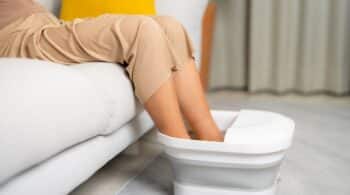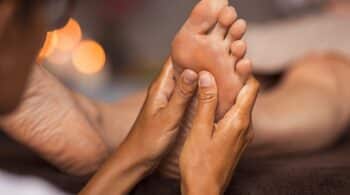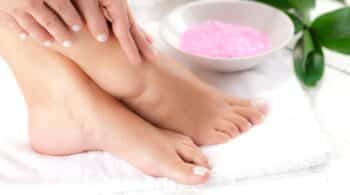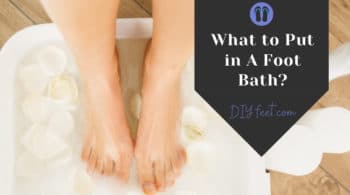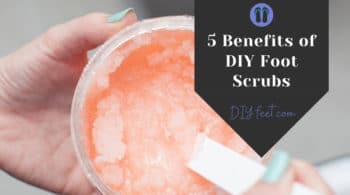Have you ever wondered if there is a natural way to alleviate pain and promote relaxation in your body? Look no further than the ancient practice of reflexology. What Does Foot Reflexology Do? Dating back thousands of years, reflexology has been used as a therapeutic technique in various cultures around the world.
Reflexology is a form of alternative medicine that focuses on applying targeted pressure and rubbing specific areas of the body, such as the feet, ears, and hands. Practitioners of reflexology believe that stimulating these areas can have a beneficial effect on organs and other body systems.
Unlike massage, which targets specific muscles, reflexology aims to stimulate the nervous system, organs, and muscles to release tension and promote overall well-being. Keep reading to learn more about adding this therapeutic practice to your foot care routine.
Feet Play a Crucial Role in Reflexology
The feet play a crucial role in reflexology, as they are believed to contain reflex points that correspond to different parts of the body. For example, the inside edge of your feet, particularly the area by the big toe, is associated with the spine. Reflexologists pay special attention to this area because it houses the nerves, bones, and muscles that communicate with the brain.
While reflexology is not widely accepted by all medical professionals, it is gaining popularity as a complementary medicine in Europe and Asia. In fact, reflexology sessions have been linked to a reduction in sick leave and increased employee satisfaction in companies. Additionally, reflexology has been used by some US doctors as a complementary treatment for conditions like diabetes, cancer, and migraines.
Throughout this article, we will explore the history and benefits of reflexology, as well as how to read and apply a foot reflexology chart to reap the maximum benefits for your body. So, get ready to discover the wonders of foot reflexology and learn how it can improve your overall wellness through the stimulation of reflex points in your feet.

What is Reflexology?
Reflexology is a therapeutic practice that has been used for thousands of years across different cultures. It involves applying pressure and stimulation to specific points on the feet, ears, and hands, known as reflexology points. These points are believed to correspond to different organs, glands, and body systems. By stimulating these points, reflexologists aim to promote overall health and well-being.
Definition of reflexology
Reflexology is a form of alternative medicine that focuses on the belief that specific reflex points on the body can be stimulated to alleviate pain, discomfort, and promote healing. It is based on the concept that these reflex points are connected to different parts of the body via energy pathways. By applying pressure and massage techniques to these points, reflexologists aim to balance the flow of energy, restore harmony, and encourage the body’s natural healing processes.
Difference between reflexology and massage
While both reflexology and massage involve touch and pressure, they differ in their techniques and purposes. Massage is primarily focused on manipulating the soft tissues of the body to release tension, improve circulation, and promote relaxation. In contrast, reflexology targets specific reflex points on the feet, ears, or hands to stimulate corresponding organs and body systems. It is more focused on restoring balance and enhancing the body’s overall functioning.
History of reflexology
Reflexology has a rich history that dates back thousands of years. Its origins can be traced to ancient civilizations such as Egypt, India, and China. However, the modern practice of reflexology that we recognize today was developed by nurse and physiotherapist Eunice D. Ingham in the 1930s and 1940s. She mapped out the reflexology points on the feet and developed techniques to apply pressure to these points for therapeutic purposes. Since then, reflexology has gained recognition and popularity worldwide as a complementary therapy.
Reflexology is a holistic therapy that targets specific reflex points on the feet, ears, and hands to stimulate healing and promote overall well-being. It differs from massage in its techniques and focus. Reflexology has a long history and continues to be embraced as a complementary therapy in various parts of the world. While further research is needed to fully understand its effectiveness, many people have reported positive experiences and benefits from receiving reflexology treatments.
How to Read a Foot Reflexology Chart
Divisions of the body in reflexology
Reflexology is practiced worldwide, but there is no consensus on the exact location of reflexology points, even on the feet. However, most reflexologists divide the body into 10 vertical areas, five on each side, which correspond to the body’s energy flow. To alleviate discomfort in a specific area, choose the foot that corresponds to that side of the body.
Correspondence between toes and body parts
The toes are believed to correspond to the head, neck, and shoulder areas of the body. The tops of the toes are connected to the sinus area, top of the head, and teeth. The middle of the third and second toes correspond to the eyes. The bottom of the toes are thought to connect to the ears, and the glands are believed to be connected through the middle of the big feet.
Connection between feet and organs
Reflexologists believe that specific areas of the feet correspond to various organs in the body. For example, the chest area is connected to the ball of the foot, with the lungs believed to be connected to the outer edges and the heart connected to the center of the ball of the foot. Additionally, the inside edge of the feet, on the big toe side, corresponds to the spine, which is important to reflexologists because it houses the nerves, bones, and muscles that communicate with the brain.
Reflexology: The benefits
Reflexology stimulates the nervous system, organs, and muscles to release bodily tension. While modern medical professionals remain skeptical, reflexology is used by some US doctors as a complementary medicine for conditions such as diabetes, cancer, and migraine headaches. However, it is important to note that there is currently insufficient evidence to support reflexology as a treatment for any medical condition, leading to it often being excluded from insurance coverage.
reflexology is a practice that applies pressure and rubbing to specific areas of the feet, ears, or hands in order to stimulate organs and alleviate bodily discomfort. By understanding the divisions of the body in reflexology, the correspondence between the toes and body parts, and the connection between the feet and organs, you can apply reflexology techniques to benefit your overall well-being.
Stimulating Reflexology Points
Techniques to Stimulate Reflexology Points
Reflexologists use specific techniques to stimulate reflexology points on the feet, ears, and hands. By applying gentle, firm pressure in a clockwise direction for about 20 seconds, and then in an anticlockwise direction for the same duration, reflexologists aim to activate the corresponding organs and body parts. Additionally, they may walk their thumbs and fingers along the reflexology points for extended periods until patients experience relief.
Proper Hydration During and After Treatment
It is crucial for reflexology patients to stay well hydrated during and after treatment. By drinking enough water, you can help flush out toxins and facilitate the healing process. Proper hydration also aids in maintaining the balance of energy in your body, allowing reflexology to have a more significant impact.
While reflexology is often regarded as a complementary medicine, some medical professionals remain skeptical. However, in countries like Denmark, reflexology is increasingly recognized and implemented in various industries. Studies have shown that reflexology sessions can reduce sick leave and absenteeism rates among employees, and many individuals reported increased satisfaction after completing a course of six sessions.
Ultimately, reflexology is a practice that stimulates reflexology points to promote therapeutic effects on the organs, nervous system, and muscles. Although not supported by enough scientific evidence to be considered a definitive treatment for medical conditions, reflexology continues to gain popularity as a complementary therapy across the globe. Its potential benefits and the art of stimulating reflexology points make it a fascinating alternative to explore for overall health and well-being.
What Does Foot Reflexology Do? The Benefits of Reflexology
Reflexology has been practiced for thousands of years and is believed to have originated in countries like Egypt, India, and China. While modern medical professionals remain skeptical, reflexology has gained popularity as a complementary medicine in Europe and Asia, with Denmark being a notable example. Reflexology sessions have been shown to reduce sick leave and absenteeism in companies, and employees have reported greater satisfaction after undergoing reflexology treatments.
Despite the lack of scientific evidence supporting reflexology as a treatment for medical conditions, some US doctors do use it as a complementary therapy for diabetes, cancer, and migraines. However, it is important to note that reflexology is often excluded from insurance coverage due to the limited evidence.
Reflexologists believe that stimulating specific points on the feet, ears, and hands can have therapeutic effects on organs and body parts. Reflexology differs from massage, as it focuses on stimulating the nervous system, organs, and muscles to release bodily tension.
During a reflexology session, reflexologists apply gentle, firm pressure on the reflexology points in clockwise and anticlockwise directions. They may also walk their thumbs and fingers along these points for several hours until patients experience relief.
Reflexology is a practice that has been used for centuries and continues to gain popularity as a complementary therapy. While its effectiveness is still a topic of debate in the medical community, many individuals find relief and satisfaction through reflexology treatments.
How to Apply Foot Reflexology for Specific Conditions
Reflexology for headache relief
If you’re suffering from a throbbing headache, foot reflexology may provide the relief you need. By pressing a specific point on your heel, you can alleviate the pain. This technique has been practiced for thousands of years and is known for its effectiveness. Reflexology points on the feet are believed to be connected to various parts of the body, including the head and neck. By stimulating these points, you can promote relaxation and reduce headache symptoms.
Reflexology for menstrual cramp relief
Many women experience intense menstrual cramps, but foot reflexology offers a natural solution. By applying pressure to a tiny point on your heel, you can achieve instant relief from the discomfort. This method is widely used and has been found to be effective in relieving menstrual cramps. By targeting specific reflexology points, you can help to balance the energy flow in your body and alleviate cramping.
Application of foot reflexology in complementary medicine
Reflexology is gaining popularity as a complementary medicine in Europe and Asia. In Denmark, for example, many companies have hired reflexologists, and studies have shown a reduction in sick leave and increased employee satisfaction. Reflexology stimulates the nervous system, organs, and muscles, promoting relaxation and releasing tension in the body. While it is still considered a suspect form of therapy by some, reflexology is becoming more recognized for its potential benefits.
By understanding how to read a foot reflexology chart and applying gentle pressure to the corresponding points on your feet, you can experience the benefits of reflexology for various conditions. Whether it’s relieving headaches, menstrual cramps, or promoting overall well-being, foot reflexology offers a natural and holistic approach to health.
Safety and Considerations
Caution in using reflexology as a sole treatment
While foot reflexology can provide numerous benefits, it is important to exercise caution and not rely solely on reflexology as a treatment for any medical condition. Reflexology is considered a complementary medicine and should be used in conjunction with traditional medical treatments. Always consult with a healthcare professional before using reflexology as a substitute for medical advice or treatment.
Lack of scientific evidence and insurance coverage
It is worth noting that reflexology is still a subject of debate among medical professionals. Although some doctors in the United States utilize reflexology as a complementary treatment for certain conditions, there is not enough scientific evidence to fully support its efficacy. As a result, reflexology is often not covered by insurance.
Despite the lack of scientific backing, reflexology has gained popularity and recognition in Europe and Asia as a form of complementary medicine. In countries such as Denmark, reflexologists are being hired by companies, and studies have shown a reduction in sick leave and increased satisfaction for employees who have undergone reflexology sessions.
Foot reflexology has been practiced for thousands of years and is believed to stimulate the nervous system, organs, and muscles. While reflexology charts can guide you in identifying specific reflexology points, it is important to approach reflexology as a complementary therapy and not a standalone treatment. Always consult with a healthcare professional for personalized medical advice, and remember to stay well hydrated during and after reflexology sessions.
Conclusion
In conclusion, reflexology is an ancient practice that has been used for thousands of years to promote healing and relaxation. While there is still some skepticism among modern medical professionals, many people have reported positive results from reflexology treatments.
Reflexology works by stimulating specific points on the feet, which are believed to correspond to different areas of the body. By applying gentle pressure to these points, reflexologists aim to promote the flow of energy and restore balance within the body.
While reflexology is not a substitute for medical treatment, it can be used as a complementary therapy for various conditions such as diabetes, cancer, and migraine headaches. It may also help reduce sick leave and absenteeism in some cases.
To experience the greatest benefits, reflexology should be applied to the left foot, as the stomach is located on the left side of the body. Reflexologists use gentle, firm pressure and may walk their thumbs and fingers along the reflexology points for relief.
While there is not enough scientific evidence to support reflexology as a medical treatment, it has gained popularity as a complementary medicine in Europe and Asia. However, it is important to note that reflexology is often not covered by insurance.
In summary, reflexology can be a beneficial practice for promoting relaxation and overall well-being. If you are interested in trying reflexology, it is recommended to seek out a trained and experienced reflexologist who can guide you through the process.




